CONSTRUCTION
Digital technology was particularly imperative to use during the construction stage, as the use of digital equipment was particularly high. We filmed “Shadow” using Sony HDV 1000 cameras with a Sony HDV 1000 tripod, to ensure a higher quality visual element, and to make certain that the shots were filmed smoothly, to make the film as realistic as possible; even the hand held shots were filmed with a certain precision so that the camera didn’t shake too much. We did this by filming the handheld scene slowly, so that the camera operator could walk as slowly as possible, in order to track the character gently. The speed was then increased through the editing process to the normal pace, to make the scene the accurate speed.

The editing process was created on an Apple Mac computer, and completed through the software Final Cut Express; here we were able to use fades, cuts and dissolves to create the film with excellent continuity. We transferred the scenes from the camera to the Apple Mac using a zoom recorder. This was a simple software to use, and was efficient in quickly converting the scenes onto the program Final Cut Express.
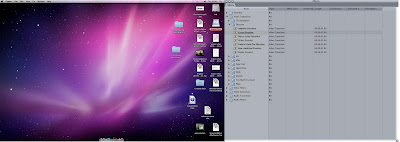
INVISIBILITY
As our invisibility effect was quite difficult to portray, our research from the internet came in very useful. We first of all used the garbage matt effect to successfully make the protagonist’s reflection disappear, with the character still visible in the frame, to give the effect of invisibility. In order to widen our creativity with the invisibility effect, we also decided to use a ripple dissolve effect on the protagonist, during the canteen scene, in order for the audience to view a range of ways in which the character is portrayed as invisible, ensuring the film isn’t repetitive with the special effects which we use.
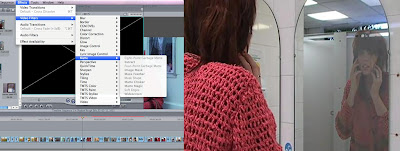
Not only was the Sony HDV 1000 camera used to film our production, but it was also used during the audience feedback, to record the target audience’s responses. This came in useful, as it was an efficient way to capture, and combine the responses together, again cutting them together through the use of Final Cut Express.
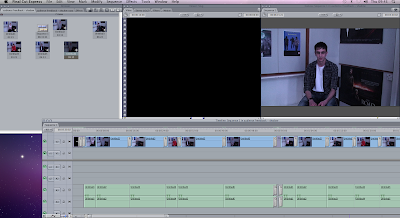
This software provided us with the tools and ability to create a professional looking short film. The software was quite difficult to understand whilst trying to resurrect the invisibility effect, but any problems were overcome by seeking technical support on search engines such as Google and by watching YouTube videos.
RADIO TRAILER: In order to construct our radio trailer, we used a zoom recorder, to record our voices in a sounds proof room, in order for our voices to sound effective, particularly the whispers, and then uploaded the recordings onto the Mac computer, through the software garage band. At first this was difficult to use, as I have no previous experience using the program, but this problem was immediately overcome, through the use of research on the internet, again using the search engine Google.
POSTER: We created this though the software Photoshop, which is an extremely effective program to use, as it allowed us to be precise in the cuts and re-sizing of the photo. The contrast was easily increased, and we added text in various different fonts, with the certification which we had previously given, to ensure that the poster looked professional and realistic, and also make certain that it denoted the genre through the use of colour, image, and text.
This is the poster which I created using the programme photobucket:
The convergence of a 3.2MP camera, with the Blackberry Curve mobile phone, to create this new media technology meant that I could take quality photographs and upload them straight to the internet using my mobile phone. This played an important part during the process of creating a poster, as it allowed me to quickly and efficiently upload the photos onto the internet, without any problems.
This process has helped me to learn about the fast paced nature of the media industry from recording to editing and to the final product as this whole process only took about an hour and a half.
PlANNING
In order for us to even begin to think about creating a film, it was imperative that we first created various different treatments, to expand our ideas, and create an idea that would be successful to use in a 5 minute film. Research from the internet, on the search engine Google came in specifically useful during the planning process, and it allowed me to research previous treatments, which had worked efficiently.
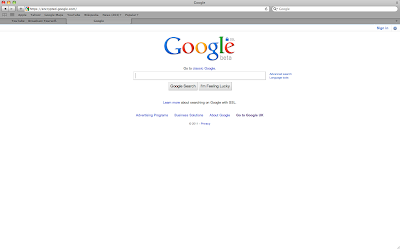
• Conventions of a thriller film
http://www.slideshare.net/Cissnei/conventions-of-thriller-films-and-tables-of-analysis
• Certification
http://www.bbfc.co.uk/
• Distribution
http://www.film4.com/features/article/online-movie-distribution
• The invisibility Effect
http://abcnews.go.com/WNT/story?id=130424&page=1
• Costume
http://www.google.co.uk/images?hl=en&rlz=1G1GGLQ_ENUK367&q=extravagant%20costume%20designs&um=1&ie=UTF-8&source=og&sa=N&tab=wi
• Music
http://www.google.co.uk/search?hl=en&rlz=1G1GGLQ_ENUK367&tbm=vid&q=thriller+genre+film+music&aq=f&aqi=&aql=&oq=
• Narrative Theories
http://en.wikipedia.org/wiki/Narratology
• Existing Short Film
http://www.bbc.co.uk/filmnetwork/
• Existing Film Poser
http://www.google.co.uk/images?hl=en&rlz=1G1GGLQ_ENUK367&q=inception%20film%20posters&um=1&ie=UTF-8&source=og&sa=N&tab=wi
• Existing Radio Trailer
http://www.youtube.com/results?search_query=teaser+trailers&aq=f
Not only was the search engine Google useful, but the website Photobucket, was useful to create the costume videos which featured the actors in their costumes, but was also used to create the initial poster design, and used to create slideshows of thriller genre research. Photo bucket allowed me to easily edit the contrast, and brightness of the images, in order for them to stand out against the page.
At the feedback stage we also tried to get people’s opinions from social networking websites. I uploaded the first cut of our product to YouTube and then posted a link on the social networking website Facebook where my friends were able to leave comments. As well as this I also posted a link to the video on another social networking site, Windows Messenger, where people left me replies with their comments on the video.
We collaborated and shared our ideas at the planning stage using online blogs. I used the popular blogging service Blogger, as it allowed me to share pictures, video and other media quickly in a neatly presented manor. This meant that whenever I was inspired be something, no matter where I was, I was able to share this inspiration with the rest of my team.
Overall new media technologies helped us to create a professional piece at a fraction of the cost and time that it would have otherwise taken. Everything from using the photo editing software Photoshop when designing our poster, to distributing media on Facebook helped us to be more efficient.
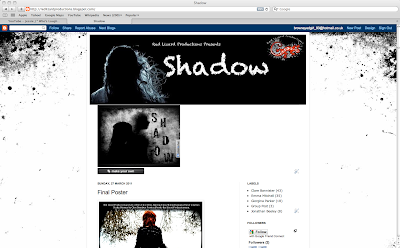

No comments:
Post a Comment